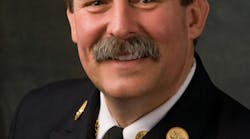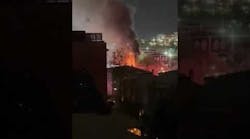The AO dispatched a full-alarm assignment that consisted of Engines 5, 2 and 8; Truck 2; Squad 2; and Battalion 2 Chief Galen Young on the initial call. As the companies responded, the AO began receiving numerous other calls in the same area for structure fires and appliance fires. Unsure of the unfolding incidents, the AO began dispatching alarm assignments to the reported structure fires.
First-due Engine 5, only two minutes from the area, reported on the scene at 1211 East Terrell with nothing showing. The crew members then advised that they had a small fire that they could handle but they could see what appeared to be a working residence fire in the next block, on Humbolt Street.
Engine 8, responding on the initial alarm, arrived at 1204 Humbolt St. to find a two-story wood-frame four-plex with the first floor well involved. Bystanders told Engine 8’s lieutenant, Jim Bradford, that people were trapped on the second floor.
Engine 8’s crew deployed a 13¼4-inch handline to darken down the main body of fire while a ground ladder was raised to rescue a woman and her two grandchildren. Engine 2 and Squad 2 assisted Engine 8 in removing the trapped occupants and knocking down the remaining fire. On arrival, Young assumed command of the incident.
The AO was continuing to receive numerous calls of structure fires and gas leaks in a 10-block area. The AO was having a difficult time in dispatching adequate resources to meet demands, as well as determining the exact locations of the incidents. The AO also announced to companies that all the incidents appeared to be natural-gas-related.
Young requested a third-alarm assignment to be sent to the staging area that had been established a few blocks away. Fire companies responding or operating at ongoing incidents could see looms of smoke and were receiving reports from citizens of structure fires throughout the area, which they reported to the incident commander.
One company officer described the incident as “cafeteria-style” firefighting — choose a structure and don’t expect any help. One or two companies were handling working fires that normally would receive full-alarm assignments.
As companies were controlling the incident at 1204 East Humbolt, where three people had been rescued over ground ladders, crews saw another structure fire at 1212 East Humbolt, only three houses away. At 1212 East Humbolt was a one-story frame residence with two rooms involved. Crews from Engines 8 and 2 and Squad 2 again went to work with a pre-connected 21¼2-inch line from Engine 8, which was still operating at the first fire. Crews were able to quickly control that incident without trouble.
Young used later-arriving battalion chiefs to divide the area into divisions and assign them companies to begin the process of shutting off the gas service to 600 homes. Companies patrolled the area throughout the night to prevent possible structure fires, as well as to assure residents of their safety.
In the follow-up investigation by the Fort Worth Fire Department Arson Division and the local gas company, it was revealed that vandals had broken into a pressure reducing manifold, called a monitoring regulator station, in hopes of removing scrap metal. The area affected was made up mostly of older homes serviced by a low-pressure gas system.
The monitoring regulator station is a two-stage system. In the first stage, pressure from the incoming gas line is reduced from 35 psi to nine ounces. The second regulator reduces the pressure from nine ounces to five. If either system fails, the pressure is still well within the operating pressure of the low-pressure system.
When the vandals damaged the manifold, they broke both sensing lines that tell the monitors the incoming line pressure. The line pressure increased to as high as 35 psi in some locations, causing pressure at homes that did not have regulators to suddenly increase. Those homes with standing pilot lights similar to those on gas ranges, water heaters and space heaters sustained all the damage; occupants reported flames extending to ceiling level when the pressure increased.
Before the night was over, 12 structure fires in eight separate blocks had injured one firefighter and eight civilians, four of whom were transported to hospitals and admitted for minor burns and smoke inhalation.
Fire companies, with the assistance of the local gas company, shut off the gas service to the area affected by the damaged monitor regulators. In all, service to about 600 homes was affected.
The four-alarm incident utilized 30 fire companies, 20 police units, four ambulances and two units from the American Red Cross. The Red Helmet Volunteer Support Group of the fire department provided rehab and canteen services. The city Parks and Recreation Department opened a nearby center to serve as a shelter for displaced residents.
The Fort Worth Fire Dispatch Center, which normally handles about 135 incidents a day, dispatched 103 incidents in only four hours while answering hundreds of other calls from worried residents.
The local gas company remained on the scene another 24 hours before gas service was restored to the area. Each home was checked, gas turned on, and pilot lights lit and adjusted. In the 75-year history of the company, this was the first such problem of sudden pressure increases. When vandals damaged both sensing lines, there was no way for the monitor regulators to control the incoming pressure.
A lesson learned in this incident: fire departments should contact natural gas providers to learn as much as possible about the local distribution system, including type of system, whether it is low or high, and locations of monitor or pressure-reducing sites, then develop plans for handling gas emergencies.
Homer Robertson is a lieutenant in the Fort Worth, TX, Fire Department.




